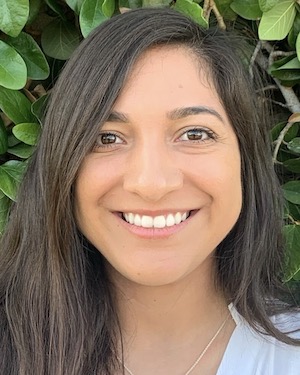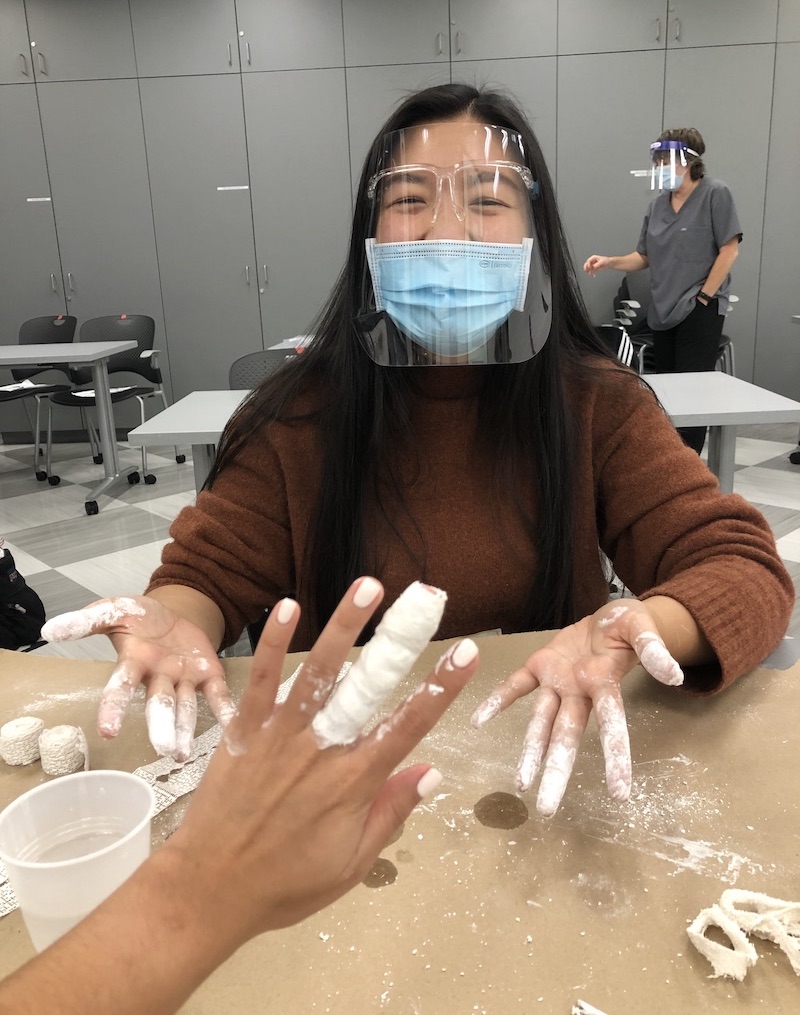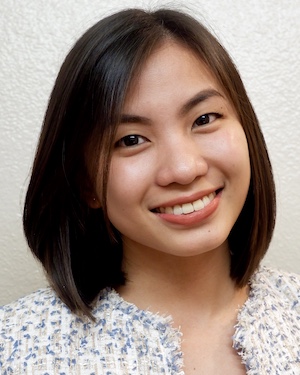Student Blog
Classes

A HANDful of Fun in Hands Electives ⟩
October 29, 2020, by Liz
Classes What are OS/OT?
The end of the semester is approaching, which means it’ll soon be time to wave goodbye to the best electives ever! Okay, yes I am biased because I really do love hands and hand therapy. I was initially pretty bummed about having to complete these electives via Zoom because I was nervous about not being able to do a lot of hands on work. No pun intended! But, I am happy to say I was proven wrong. I’ve had a blast learning in both OT 573: Hand Rehabilitation and OT 562: Advanced Hand Rehabilitation and Certification (PAMs).
Lisa Deshaies is the instructor for OT 573, and I have learned so much. We’ve learned about the anatomy of the hand, which I have to admit was really intimidating to think about at first! Lisa does a wonderful job of going over the anatomy of the hand and has some wonderful tips on how to remember different parts. In her class we’ve also learned about several different diagnoses, such as osteoarthritis, arthritis, and carpal tunnel syndrome to name a few. We’ve discussed the importance of wound care and the different phases of healing. We’ve talked about different orthoses and have had the opportunity to critically think about which orthosis we would recommend given different client cases. Lisa has shared so many resources with us to continue practicing our knowledge of anatomy and is so patient when explaining different concepts in class. This week we had our first in-person course, where we practiced casting. It was so much fun! I had seen this done at the hand therapy clinic I worked at, and I finally got to try it. Here’s some pictures!

My partner and MA II student, Bethany, made a pretty awesome cast on my finger!

My attempt at casting Bethany’s fingers. It was fun to get a little messy and practice!
In OT 562 we’ve learned about a multitude of physical agent modalities that may be used in hand therapy practice. We’ve learned about ice/ice massage, hot packs, ultrasound, transcutaneous electrical nerve stimulation (TENS), neuromuscular electrical stimulation (NMES), paraffin, iontophoresis, and phonophoresis. Aside from learning about the modalities from our instructor, we’ve had a chance to learn from each other. Each student has had a chance to become familiar with one of the modalities I listed and presented during our small groups. We’ve learned about the precautions and contraindications, parameters, and when/why we would use the modality with clients. Dr. Rocker is extremely knowledgeable and has challenged us with multiple case studies that allow for us to critically think about which modality, if any, we would use in different cases. Some of the cases presented in class are cases that Dr. Rocker has seen in practice, which is really cool! We’ve had class on campus to try out ultrasound (sorry, I forgot to take some pictures!). We also had TENS/NMES units mailed to us from the Division, which we’ve had a chance to try out during class. It was a really cool experience to know what the modality feels like, and how it would be beneficial for certain clients. A little class fun this week included dressing up for Halloween. I really appreciated that Dr. Rocker continues to try and make class fun for everyone even though we aren’t on campus as we would usually be.

Check out my costume — I am supposed to be a goniometer!

The lovely Trojans I’ve been working with in PAMs all semester showing their Halloween costumes!
If you’re as passionate about hands as I am, you’ll definitely get so much out of these two electives. The content is extremely relevant to hand therapy practice. If you’re interested in becoming certified in PAMs, CBOT requires a minimum of 30 educational hours and 240 supervised hours of PAMs training. The PAMs course counts towards 33 educational hours — so, you would be done with that part! All that’s left to worry about is obtaining the direct training in PAMs, which you could start accumulating hours for when out in practice as a certified OT. Pretty awesome!
⋯

Working with Real Clients (not actors) ⟩
October 23, 2020, by Lamoni
Classes
During your time in the Master’s Program and in the Adult Rehabilitation immersion, specifically, you will have several opportunities to work with actors that will serve as your client. This allows you to practice the techniques that your instructors and textbooks have been talking about. It is pretty nerve wrecking in the beginning because you do not want to “mess up.” But this is technically what they are there for. If you do it incorrectly the first, second, third time, it is okay. Each time that you practice, you get closer to using the correct form or using the correct language. The great thing is that the actors give you feedback too! You do not have to wait until your professor comes over. The actors will let you know if your directions were not clear or if your position was awkward and what you should try next time.
While it is great practice to have those actors as clients, it definitely does not compare to working with actual clients. During my Level I fieldwork at a hospital, I was presented with new challenges that I had not thought about. Clients would ask questions that I did not have the answers to, they would get off track and sometimes it was difficult to redirect them, and there were times when they said things that were a cause for worry. However, my clinical instructor was always right there to guide those situations. For the most part, I was observing and taking mental notes.
Due to COVID-19, the structure of the program has changed. Instead of doing my first Level II fieldwork during the summer, I will not be starting until the spring. That means that I went a couple of months without seeing a client (whether real or an actor). I was feeling rusty. However, I have had the perfect opportunity to work in the middle ground during this semester! My elective, Enhancing Motor Control for Occupations, has in-person sessions and involves volunteer clients!
We began this course by discussing what we would cover and how everything would be laid out. The purpose of the course is to provide an in depth understanding of “principles and methods for remediation of motor control problems following upper motor neuron lesions” (OT574 Syllabus, 2020). The perspective of the course is to examine the ways that occupations are impacted for adults with hemiplegia. Our first two classes covered pelvic and trunk assessment, scapular assessment, and shoulder alignment. We had practiced facilitations and mobilizations on our assigned partners which were other students in the class but because everyone had normal strength and movement (and none of us were trained actors), it felt rather . . . easy? It took some time to get the proper form but other than that, the client (ourselves) was simple.
After those first two classes, our volunteer clients arrived! The client that I was assigned to had a much different presentation than my classmate. While my partner is 5’6 and no more than 130 pounds, my client, Chuy, was 6’1 and over 300 pounds. He had a stroke a couple of years ago and presented with left side hemiplegia that caused weakness in his arm and flexion in his hand. He wanted to be able to tie his shoes and zip up his jacket independently. He had very functional goals and it was time to help him achieve them! Our interventions were completed through both in-person and Telehealth sessions. Every week, we had an entire two hours to work with our clients. Afterwards was the lecture portion by our instructor Remy Chu.

Group photo of my team and Chuy! (Left to right: Elizabeth Goodman, Sydney Bast, Emeli Castillo, Daphne Carcedo Cravens, Brianna Hernandez, and Lamoni Lucas)
The last session with clients ended this week; we wrote discharge notes and gave them home exercise plans. Spending time with clients in this environment was an amazing opportunity. Everything we learned in lecture was being applied on the spot. And none of the clients had to pretend that they had weakness or impaired sensation or limited range of motion because it was actually the case. Therefore, by the end of our time with them, we were able to see real progress! We started and ended our time with clients by recording their movement and the how they performed their goal. We were able to compare them at discharge to how they were at baseline. In our last session which was through Telehealth, Chuy independently tied his shoes and with a big smile, asked “did you see that?!” It was such a rewarding feeling! I almost shed a tear. That feeling is not something that actors can provide. When working with clients, I am constantly reminded of why I chose this field.
⋯

Back To OT School Day ⟩
October 19, 2020, by Calvin
Classes Videos
I hadn’t been back to school since like . . . March, which was around the time when we were all informed that courses were going to be moved online due to the pandemic. Ever since then, I’ve missed being with everyone in person, and I also kind of missed sitting in the classroom and being in that learning space. I’m so thankful that the division is allowing students to go back to class on some days because honestly, there are just some things that are learned better in person!
At first, I was pretty hesitant about going back because of the potential risk, but so far it’s been working out great! We’ve learned to be more flexible in order to adapt to this new learning format, and it feels good to see everyone again. Here’s a video on what my first day back to school looked like!
⋯

Savi’s Electives Experiences ⟩
October 7, 2020, by Savi
Classes
Over the past two semesters, I have had the opportunity to choose between a variety of elective courses to take in order to dive deeper into the subject matter I am interested in and begin my journey from an OT generalist to specialist. As a second year in the Master’s program, students are given the chance to take 12-14 units of elective coursework so that they can begin to focus in an area of interest.
When I began this Master’s program I was extremely interested in taking the OT 561: Occupational Therapy in Acute Care elective, as I have always been interested in pursuing a career in acute care. Unfortunately, this elective was no longer offered this semester as they wanted to keep all students, faculty, and patients healthy and at a safe distance. Although this was sad news for me, this decision also allowed me to explore electives I wouldn’t have otherwise! Now looking back on my decisions and experiences I could not have imagined it any other way! I love all of my electives and have learned such valuable information that will help guide me in whatever practice setting I choose in the future. Here is a glimpse into my electives and why I chose them!
OT 574: Enhancing Motor Control for Occupation
This semester I was fortunate enough to have been randomly selected to take the Motor Control elective at the California Rehabilitation Institute. This course has opened my eyes to so many unique and fun things OTs can do in an inpatient rehabilitation setting. Before beginning this course I knew that I wanted to hopefully work as an OT in an inpatient rehabilitation or acute setting after graduation, but was worried I wouldn’t have experience working with patients in either of these settings. This course provided me with four hours of weekly clinical experience with patients guided by an assigned clinical instructor, as well as lecture material focused on providing tangible methods for remediation of motor control problems following upper motor neuron lesions. In lectures, we spent half the time learning the theories and concepts of motor control and motor learning, and then the other half applying our knowledge and skills in practice. Through this class, I learned how to complete scapular and trunk assessment, facilitation, and mobilization, shoulder subluxation positioning and taping, inhibitory casting, neuromuscular electrical stimulation, edema management, and much more! Check out the pictures at the bottom to see what these look like. I had a lot of fun working with patients and applying my knowledge in real-time with the assistance of experienced OTs.
OT 575: Dysphasia Across the Lifespan
As a food lover myself, I have always listed eating as my #1 favorite occupation. After working in a few pediatric settings and seeing how impactful OTs can be in the feeding process, I wanted to learn more about our impact across the lifespan. This course has provided me with an immense amount of knowledge regarding the various assessment and treatment strategies used for patients and caregivers. I have also gained a greater understanding of the oral, pharyngeal, and esophageal anatomical structures involved in swallowing and how they relate to normal and abnormal swallowing. On the last day of class we all received a large box of delicious snacks to eat and test out. This helped us gauge the sensory qualities, understand the effects chewing has on consistency and texture, and brainstorm fun activities with each snack option to engage our future clients.
OT 566: Healthcare Communication with Spanish-Speaking Clients
¡Hola! Mi nombre es Savi y yo soy su terapeuta ocupacional. I am extremely passionate about developing a comfortable and safe environment for all my clients. During my time completing observation hours in San Diego and fieldwork in Los Angeles, I have noticed that a large quantity of the patients and clients I have worked with are primarily Spanish speaking. Because of the language barrier, I felt as though I am not able to make them feel as comfortable as I could. I, therefore, wanted to take advantage of this opportunity to learn how to communicate in Spanish at an elementary level in a therapeutic context. By doing so I have learned how to say common OT phrases and terms in Spanish, to facilitate better connections and relationships with my future clients. Dr. Delgado has brought in OTs from a variety of settings to help us learn context-specific and cultural terms and phrases. Gracias, Profesor Delgado!
OT 564 Sensory Integration Theory
I decided to take sensory integration (SI) theory because I wanted to get a better understanding of the neuroscience backing and foundation for sensory integration. After completing the pediatrics immersion, I didn’t feel confident about the level of understanding I had regarding SI in comparison to other students I had spoken to in my cohort. This made me extremely nervous since SI is so important and prevalent in OT practice across all settings. I, therefore, wanted to get a better grasp on the neurobehavioral principles of Sensory Integration Theory before entering into my Level II fieldwork and eventually sitting for the NBCOT exam. This class did just that!

Showing off my shoulder taping, which is used to assist with realigning and supporting a shoulder joint with subluxation.

Practicing serial casting on classmate Alana Schoenhals to manage tone. We even got to saw off the cast we made!

Classmate Alana Schoenhals and I showing off our compression bandage treatment after doing retrograde massage on one another for edema management.
⋯

My first time on campus ⟩
October 2, 2020, by Yna
Classes Videos
From the time I enrolled in my Master’s program at USC, one thing I had really been looking forward to was getting to visit the beautiful campus that I have only been seeing in pictures. Unfortunately, due to the pandemic and in efforts to socially distance, I have not been able to do this since most of our classes had to be held remotely. One of the courses I was enrolled in, however, entailed an on-campus lab class which gave me the opportunity to finally visit the campus for the first time!
If you’d like to see my experiences during my first time on campus and are curious about the safety protocols in place to keep the Trojan community safe and healthy, check out my video below!
[Credits to Elmo Nicolas for some of the video clips]
⋯





